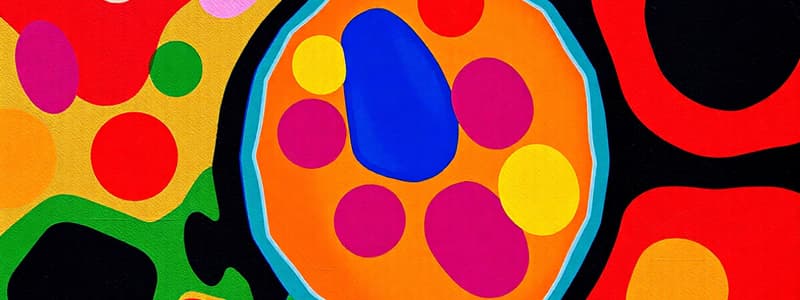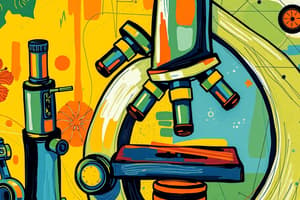Podcast
Questions and Answers
What characterizes compound epithelium?
What characterizes compound epithelium?
- It is made up of a single layer of cells.
- It is avascular and lacks a basement membrane.
- It always has nucleated cells on the free surface.
- It contains two or more layers of cells. (correct)
Which type of epithelium can undergo a change in shape and structure?
Which type of epithelium can undergo a change in shape and structure?
- Simple squamous epithelium
- Cuboidal epithelium
- Stratified epithelium
- Transitional epithelium (correct)
What is the main function of connective tissue proper?
What is the main function of connective tissue proper?
- Facilitating rapid electrical impulses.
- Transporting nutrients throughout the body.
- Storing genetic information.
- Providing structural support and connecting different tissues. (correct)
Which type of cell junction allows for communication between epithelial cells?
Which type of cell junction allows for communication between epithelial cells?
Where is areolar connective tissue primarily located?
Where is areolar connective tissue primarily located?
What type of fibers provide tensile strength to connective tissue?
What type of fibers provide tensile strength to connective tissue?
What biological function does the transitional epithelium serve?
What biological function does the transitional epithelium serve?
Which type of connective tissue has a viscous matrix with dispersed fibers and cells?
Which type of connective tissue has a viscous matrix with dispersed fibers and cells?
What primarily characterizes elastic cartilage?
What primarily characterizes elastic cartilage?
Which of the following statements about bones is true?
Which of the following statements about bones is true?
Which type of bone lacks a Haversian system?
Which type of bone lacks a Haversian system?
What are myofibrils composed of?
What are myofibrils composed of?
What distinguishes skeletal muscle from other types of muscle?
What distinguishes skeletal muscle from other types of muscle?
What is the primary function of the periosteum?
What is the primary function of the periosteum?
What is contained within the lacunae of bone tissue?
What is contained within the lacunae of bone tissue?
What type of muscle tissue is known as non-striated and involuntary?
What type of muscle tissue is known as non-striated and involuntary?
Where are skeletal muscles primarily located?
Where are skeletal muscles primarily located?
Which characteristic is NOT associated with smooth muscle?
Which characteristic is NOT associated with smooth muscle?
What structural unit is responsible for the contraction in skeletal muscles?
What structural unit is responsible for the contraction in skeletal muscles?
What feature distinguishes cardiac muscle from skeletal muscle?
What feature distinguishes cardiac muscle from skeletal muscle?
Which of the following describes the contraction type of skeletal muscles?
Which of the following describes the contraction type of skeletal muscles?
Which part of the sarcomere is responsible for the dark band appearance?
Which part of the sarcomere is responsible for the dark band appearance?
What is a key feature of smooth muscle fibers?
What is a key feature of smooth muscle fibers?
Which statement accurately describes skeletal muscle fibers?
Which statement accurately describes skeletal muscle fibers?
What is the function of fibroblasts in connective tissue?
What is the function of fibroblasts in connective tissue?
What type of tissue acts as a good insulator and source of energy?
What type of tissue acts as a good insulator and source of energy?
Which type of connective tissue has collagen fibers arranged in parallel?
Which type of connective tissue has collagen fibers arranged in parallel?
Where is hyaline cartilage found?
Where is hyaline cartilage found?
What distinguishes brown adipose tissue from white adipose tissue?
What distinguishes brown adipose tissue from white adipose tissue?
What is the primary role of ligaments in the body?
What is the primary role of ligaments in the body?
What is the composition of the extracellular matrix in cartilage?
What is the composition of the extracellular matrix in cartilage?
What type of cells are chondrocytes in mature cartilage?
What type of cells are chondrocytes in mature cartilage?
What type of heart can generate its own impulse for contraction?
What type of heart can generate its own impulse for contraction?
Which type of cardiac muscle requires neural stimulus to initiate contraction?
Which type of cardiac muscle requires neural stimulus to initiate contraction?
Which component of the nervous tissue is responsible for supporting cells?
Which component of the nervous tissue is responsible for supporting cells?
What is the term for the process by which neurons carry impulses from dendrons to axons?
What is the term for the process by which neurons carry impulses from dendrons to axons?
What provides insulation to myelinated neurons and prevents the loss of impulses during conduction?
What provides insulation to myelinated neurons and prevents the loss of impulses during conduction?
What is the functional contact point between axonal ends and dendrites of adjacent neurons called?
What is the functional contact point between axonal ends and dendrites of adjacent neurons called?
What is the term for the rapid transmission of impulses in myelinated neurons as they jump from one node to another?
What is the term for the rapid transmission of impulses in myelinated neurons as they jump from one node to another?
What characteristic prevents neurons from dividing and regenerating?
What characteristic prevents neurons from dividing and regenerating?
Flashcards are hidden until you start studying
Study Notes
Cell Functions and Tissue Types
- Cells detect external and internal stimuli, central to their function.
Epithelial Tissue
-
Characteristics of Compound Epithelium:
- Comprises two or more layers of cells with a basement membrane.
- Contains nucleated cells in the stratum germinativum; the outer layer (stratum corneum) is flat and non-nucleated.
-
Types of Epithelial Tissue:
- Stratified Epithelium: Located in the epidermis, esophagus, cornea, and vagina; serves primarily for protection.
- Transitional Epithelium: Found in the urinary bladder, adaptable in shape and structure according to stretch.
-
Cell Junctions:
- Epithelial cells link laterally and to the basement membrane via junction complexes.
- Junction types include tight junctions, gap junctions, adherens junctions, desmosomes, and hemidesmosomes.
Connective Tissue
-
Characteristics:
- Most prevalent tissue type, characterized by fibers and various cells in a matrix.
- Vascular, except for cartilage.
-
Types of Connective Tissue:
-
CT Proper:
- Loose CT: Areolar and Adipose tissues; serves as packing material and aids in healing.
- Dense CT: Divided into regular (parallel collagen fibers found in tendons and ligaments) and irregular (randomly arranged in the dermis).
-
Supporting CT: Includes cartilage and bone.
- Cartilage:
- Pliable and tough, involves chondrin and perichondrium.
- Types: Hyaline, Elastic, Fibrocartilage, Calcified.
- Bone:
- Characterized by a hard matrix (ossein).
- Organized into Haversian systems; contains osteoblasts, osteocytes, and osteoclasts.
- Types: Spongy (trabecular) and Compact (lamellar).
- Cartilage:
-
Muscular Tissue
-
Characteristics:
- Known as contractile tissue, vascular and innervated. Muscle fibers are elongated.
-
Types of Muscular Tissue:
-
Skeletal Muscle (Striated):
- Attached to bones; enables quick, strong voluntary contractions.
- Fibers are multinucleated with a striated appearance due to sarcomeres.
-
Smooth Muscle (Non-Striated):
- Located in visceral organs; undergoes slow involuntary contractions.
- Spindle-shaped fibers with a single central nucleus.
-
Cardiac Muscle:
- Found in the heart wall, combines features of both striated and non-striated muscles.
- Fibers are branched and possess intercalated discs for rapid stimulus transfer.
- Myogenic (self-impulsing) in contrast to neurogenic (requiring neural stimulation).
-
Nervous Tissue
-
Composed of neuroglia (supporting cells) and neurons.
-
Neuroglia:
- Non-nervous supporting cells; capable of regeneration.
-
Neuron Characteristics:
- Structural and functional unit of the nervous system; incapable of division.
- Transmit impulses through changes in membrane potential (excitability) and impulse conduction (conductivity).
-
Structure of Neuron:
- Consists of a cyton (cell body), dendrons (impulse-receiving branches), and axon (impulse-transmitting extension).
- Myelinated axons are enveloped by myelin sheath, enhancing signal transmission via saltatory conduction at Nodes of Ranvier.
-
Synapse:
- Functional connection between axon terminals and dendrites, facilitating impulse transfer between neurons.
Studying That Suits You
Use AI to generate personalized quizzes and flashcards to suit your learning preferences.




